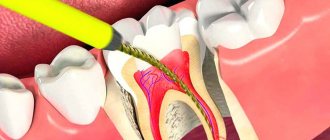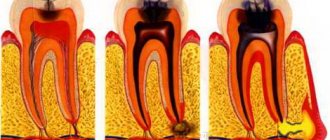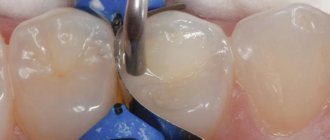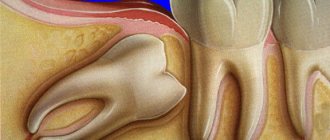Specialists in modern dentistry sometimes carry out such a procedure as replacing a filling. The reasons may be different, for example: a long-established filling (from amalgam, old mixed materials and cements) that needs updating. There are also more serious motives.
The filling serves to restore the original shape of the tooth, use it in the chewing process, and also to prevent its further destruction.
Over time, darkening appears in place of old fillings, indicating the presence of small cracks and further development of caries. At this point, replacing the filling is the best option (despite the fact that the filling may still hold well for some time).
In order to place a new filling, you must first remove the old filling.
The filling is made from different materials, so removal is individual for each option.
Pastes
Almost all types of pastes can be easily removed using a regular solvent. First, using Girdwood burs and long round burs, and then Hedström files or new reamers, the filling is removed. If removal occurs from the canals, then it is necessary to know exactly the length of the tooth, which is done using x-rays. It is also necessary to irrigate the canal frequently to remove any sawdust that appears.
After the filling is removed, it must be replaced with a new one. The most common of them are a light (light-polymer) filling, which is most often installed on the front part of the teeth, a cement filling (zinc phosphate, glass ionomer, zinc eugenol), as well as an inlay.
How long does a filling last?
The minimum service life of a filling is considered to be 3-5 years. Some materials last longer, up to 10 years. Much depends on the condition of the treated tooth after the minimum period.
What affects the service life of the filling:
- how correctly the dentist selected the size and installed the filling;
- the material from which it is made;
- what is the thickness of the walls of the abutment tooth and what condition is it in;
- what hygienic care is required: abrasiveness of pastes, hardness of the brush, use of special products;
- whether the patient has bad habits that have a harmful effect on the filling material;
- how much solid or tough food is in the diet, whether the temperature of food and drinks is moderate, etc.
Sealing
High-quality tooth filling occurs in 40-60 minutes. Root canals are washed using antiseptic agents and filled with sealed material. If the canals have been sealed professionally, then future infection is excluded.
The next step is filling the tooth cavity. The dentist installs the required matrix on it, suitable for the further shape. Then an adhesive (good adhesive) composition is applied and work is done on the future filling. The filling is laid in layers. The final stage involves adjusting the filling to the bite and polishing it.
In order to avoid replacing fillings, you need to carefully monitor your dental hygiene and visit the dentist as often as possible.
When to refill
The following conditions indicate the need to replace the filling:
- Pain in a filled tooth.
- Crown destruction.
- The appearance of caries on a tooth.
- Constant unpleasant taste in the mouth.
- Deterioration of restoration aesthetics.
- The seal has expired.
If you notice such signs, you should contact your dentist so that during an examination, a specialist can determine the cause and prescribe a procedure to replace the filling and re-treat the tooth.
In addition, a new filling should be installed in the following situations:
- The color of the filling has changed (yellowness, darkening has appeared). This indicates the beginning of the destructive process in the tooth. If the filling turns red, it will most likely require not only a refill, but also cleaning of the dental canals and intra-canal bleaching.
- Abrasion of the seal. The relief of the filling changes, the distribution of the chewing load is disrupted. Changes occur in the bite, digestive disturbances, and problems with the TMJ may occur.
- Overhanging filling. Food debris accumulates in hard-to-reach areas, inflammation appears in soft tissues, gums bleed, and caries develops.
- Compaction of the filling. The material begins to pull the tooth tissue along with it, cracks and chips appear, and inflammatory processes develop.
- Flat filling surface. A competent dentist forms fissures and bumps on the surface of the filling material, which correctly distribute the chewing load. If this is neglected, contact with the opposite teeth of the other jaw is disrupted, and the bite becomes incorrect.
- Appearance of roughness. Indicates the formation of pores and microcracks, therefore, the tightness is broken and there is a risk of caries formation. Not only the fact of installing the seal is important, but also proper grinding and polishing.
Discomfort and inconvenience after installation of a filling
Immediately after a filling, the cause of discomfort in the mouth may be the lack of treatment before the filling is placed, and having a healthy tooth can create an unusual feeling of something new.
discomfort conditions of a filled tooth are a reason to urgently consult a doctor
- Foreign body sensation requires diagnosis to determine the origin of the discomfort. If you ignore such a symptom, there is a possibility of developing more complex inflammatory processes.
- A feeling of roughness and scratching indicates insufficient polishing of the filling. The defect is quickly eliminated with a second visit to the doctor and additional polishing to a comfortable state.
- An incorrect bite indicates an incorrect formation of the shape of the filling, which is measured in fractions of millimeters. The reason for this situation is the fact that anesthesia, which continues for some time after the filling procedure, does not make it possible to fully feel the shape of the tooth. Numbness of the jaw under the influence of anesthetics makes it difficult to report the presence of discomfort in the dentist’s office immediately after the filling is installed. The shape of the filling is quickly corrected by filing during a second visit to the doctor.
- A tightening tension in the jaw, a feeling of pressure inside the filled tooth, and discomfort when closing the teeth are created by an oversized filling. This is caused by increased pressure on the tooth walls and nerve endings. Possible consequences range from microdestruction of the dental wall to bacterial inflammation, from malocclusion to diseases of the temporomandibular joint.
- An incorrectly shaped filling can also create additional trauma to the oral mucosa when wearing orthopedic structures.
- Some time after the filling is installed, an increased reaction to irritants even without them (sour, cold, etc.) goes away with the correct selection of paste and other means. A sensitive reaction can be triggered by overdrying of the dentin during filling or loss of tightness of the filling material. To get rid of unpleasant sensations, the intervention of a doctor is necessary.
- Uncomfortable sensations during eating and the entry of food particles into the interdental spaces require the restoration of the interdental contact point, which determines the anatomical correspondence of the filled tooth with the rest of the teeth.
- An allergy to the components of the filling material is sometimes accompanied by bitterness in the mouth, pain, and skin reactions: itching, rash. In such a situation, the filling is replaced with a material that does not cause an individual reaction.
Dental specialists at Die Hard will individually consider the causes of discomfort after installing a filling and eliminate them, providing you with the comfort of healthy teeth. Dentistry in Moscow will cope with even the most complex inconveniences that appear after filling.
How does the replacement work?
Let us note right away that the procedure is carried out under local anesthesia and discomfort is minimized due to this.
In general, replacing a filling is carried out as follows:
- anesthesia is administered;
- the desired tooth is isolated from the rest by a rubber dam in order to protect them from pathogenic microorganisms;
- the old filling is removed, the tissues are cleaned of caries if necessary;
- the cavity is treated with drugs and dried;
- make an insulating or medicinal pad;
- a new filling is installed.
If we are talking about restoration, then it is carried out taking into account all the anatomical features of the chewing surface.
Remember that regular preventive examinations help to identify pathologies and defects in a timely manner. Agree, it is better to spend a few minutes polishing the filling than to replace it globally after some time. This will not only save you money, but also keep your teeth and nerves healthy.
What does judicial practice say?
If we turn to legislative acts, then the Resolution of the Presidium of the Supreme Arbitration Court of the Russian Federation dated March 20, 2012 No. 14316/11 states that regardless of whether the carrier is guilty or not of violating the rules for transporting goods, he is not exempt from liability. The only exception to the rules is the occurrence of force majeure situations that cannot be predicted or eliminated. But this type of force majeure mainly includes emergencies of a natural and man-made nature.
In the Russian Federation, judicial practice is formed in such a way that in such cases, carriers, as a rule, lose in court. However, it still happens that transport companies prove their innocence in the fact that the cargo was transported correctly and in accordance with all requirements and standards.
A guarantee that there will be no claims against the cargo carrier is also provided by a correctly completed consignment note in the part where it is indicated which cargo and its weight were accepted for transportation. In addition, the entire seal indicates that there should be no claims against the carrier in terms of compliance with cargo transportation rules.
What to do if the seal on the water meter is broken. Unmetered water consumption
When registering a water meter, a representative of the service company seals it and writes down the seal number in the report (by the way, now many resource supply companies install anti-magnetic seals on the water meter), and also records the current meter readings.
The seal is installed in order to prevent unauthorized persons from interfering with the operation of the device for the purpose of illegal use of water.
But sometimes circumstances develop in such a way that the seal on the water meter was torn off without malicious intent.
What to do next, and will there be a fine for this?
What is considered unaccounted for water use, and what is the punishment for it?
Before moving on to the problem of a broken seal, you need to figure out what is considered unmetered use of water, and what is interference in the operation of the meter or unauthorized consumption.
Unmetered water consumption is the consumption of water in the absence of metering devices (there may be various reasons - the meter is out of order, was never installed).
Illegal water consumption (as well as interference with the operation of the meter) is considered under the following conditions:
- Each subscriber using water must enter into an agreement with the company providing such service. Consumption of water in the absence of such an agreement is an unauthorized connection.
- Unauthorized connection of a home water supply to the central system without the appropriate documentation authorizing these actions is considered illegal.
- Interference with the operation of a water meter is considered to be: the presence of mechanical damage to the water meter, loose fitting of the indicator glass, or violation of the integrity of the seal.
However, not every unmetered water consumption is punishable by large fines: if the meter simply fails for reasons beyond the control of the consumer, then the supplier makes a calculation based on the average consumption of the utility resource over the last 6 months.
In other cases (in case of unauthorized connection, breaking the seal and failure to report this fact, or interfering with the operation of the meter), this is punishable by a fine.
Punishment for illegal use of water
With the rise in prices for utility bills, cases of water theft have become more frequent. Supply companies began to actively fight against unaccounted consumption. If unaccounted use of water is detected, especially during unauthorized connection, the subscriber has the right to take the following actions:
- a representative of the resource supply or management company draws up a report on unauthorized connection to water supply systems or a report on interference with the operation of the metering unit;
- The cost of consumed water is recalculated for the last 3 months or from the date of the last inspection based on the power of unauthorized connected equipment (for unauthorized connection) or based on ten times the water consumption standards.
What does the subscriber face if the seal is accidentally broken?
An ordinary seal in the form of a lead or plastic stamp is hung by the inspector on the meter using a thin wire, fishing line or thread. Sometimes they rot on their own due to dampness. It happens that a person accidentally gets caught on a seal or children can tear it off. There are many options.
The legislation does not provide for a fine for accidentally breaking a seal from a metering station; however, there are some pitfalls. If the subscriber lives in an apartment building where a HOA has been created, the amount of the fine may be separately displayed in the contract. In other cases, the service provider is guided by current legislation.
If the seal was accidentally broken, the subscriber must immediately report the fact of the seal breaking and the current readings at the time of its breaking to the resource supplying organization (HOA or management company).
In this case, failure of the seal will be regarded as a breakdown of the water meter. In accordance with 59 Decree of the Government of the Russian Federation No. 354 of 05/06/2011, the subscriber is allowed to recover the cost of the resource based on the average monthly volume of water consumption during the period of absence of the seal.
If you do not notify the water supplier about the seal being broken, and this fact is revealed during the inspection, then the calculation will be made for cases of interference with the operation of the metering unit - based on ten times the volume.
What to do with an accidentally broken seal so as not to be accused of interfering with the operation of the meter?
To avoid charges of interfering with the operation of the water meter after an accidentally broken seal, you must contact the service provider before repairing your apartment or replacing plumbing. Even if the old water supply is supposed to be replaced, a company representative will document the removal of the seal, as well as the meter, and the whole process will be painless and without consequences.
If a seal accidentally breaks, you should not put the problem on hold and immediately contact the appropriate water meter service organization. This could be a management company, HOA, water utility or other service company.
The most correct way would be to submit a written application in two copies. One of them remains with the subscriber. The application shows the reason and time of the seal failure, and also stipulates the date of arrival of a representative to carry out a new seal. The second copy of the application will be useful to the subscriber if the controller fails to appear on time. The document will not give the right to charge a fee for using water without a meter based on ten times the standard.
If it is impossible to visit the company in person, one copy of the application can be sent by registered mail with mandatory notification of receipt. In any case, a timely submitted application relieves the subscriber of a fine for accidentally breaking the seal. If, after checking the metering unit and payment receipts for previous months of water use, no violations are revealed, the apartment owner will only have to pay for a new sealing of his water meter.
Based on your application, a representative of the resource supply company will easily seal the cold water or hot water meter and the problem will be solved.
Still have questions? Do you want answers to them?
Here you can ask a question free of charge to the experts or lawyers of the gkh-konsultant.ru portal.
When is it time to replace an old filling?
The reason to contact a dental clinic is the appearance of the following symptoms:
- reaction of teeth to changes in food temperature;
- darkening of the enamel or the filling itself, chips, mobility;
- constant bad breath;
- bleeding, inflammation or discoloration of the gums.
The presence of secondary caries is difficult to detect during an external examination, so in dentistry a visiograph, a new generation device, is used for this purpose. He takes a picture of the tooth, and the data is processed by a computer program. Moreover, the radiation dose when using it is several times less than with a conventional x-ray examination.
Possible consequences
If the dentist installed the filling incorrectly, and the patient is afraid or does not want to go back to fix this problem, then there is a high probability of negative consequences developing. These include:
- Pulpitis and periodontitis. They are the result of an over-inflated filling. That is, there is constant and strong pressure on the tooth, which leads to chronic injury. Because of this, the enamel on a person’s teeth wears off, which leads to the re-formation of caries. If the filling is not corrected in a timely manner, the tooth will have to be depulped.
- Chipped tooth surface. It also occurs due to constant pressure on the tooth that has been filled.
- Dislocation. It can happen if, when closing the mouth, the teeth close unevenly and incorrectly on different sides. In other words, a misalignment occurs and pathology of the temporomandibular joints develops. The main signs of this problem are: pain, crunching, clicking.
After the treatment, it is very important how the dentist filled the tooth. If the filling begins to interfere with the motor functions of the lower jaw, then it is worth telling the doctor about this so that he can polish it again.
It’s easy to check if the filling is in the way. You just need to move your lower jaw to the right, left, forward, and also leave your mouth open. If you feel pain or discomfort, you should immediately inform your dentist so that he can fix the problem.
People who do not want to go for a second appointment mistakenly believe that over time the filling will wear off and stop causing discomfort. Of course, a feeling of addiction may arise, but it will not in any way affect the solution to the problem. You cannot do without the help of a dentist.
The sooner you re-visit the doctor and adjust the filling, the lower the risk of developing negative consequences and dental diseases.
Doctor's actions
The dentist must act and take measures based on the reasons that led to discomfort after dental treatment. There may be several situations:
- The discomfort does not go away within several days. You should definitely visit a doctor who will polish the filling in a couple of minutes. Otherwise, negative consequences may begin to develop and tooth decay may occur.
- If the edges of the filling are too sharp, they can cause injury to the gums, tongue or cheek. In this case, you should immediately visit the dentist so that he can immediately polish the filling, thereby preventing possible injuries.
- A crack remains between the filling and the surface of the tooth. You should definitely see a doctor again, as bacteria and microbes will get into the gap that has formed, which will trigger the development of caries.
Also, do not ask the doctor to file down the filling too much. The teeth of the upper and lower jaws must be in close contact with each other while chewing food. If this does not happen, then the person’s bite will be disrupted.
If a filling falls out, what should you do yourself?
The first thing you need to do is remove the old filling from your mouth so you don't accidentally swallow or inhale it. In most cases, if a patient accidentally swallows a filling, it will pass through the stomach and intestines without problems.
A filling that has fallen out does not need to be put back into the tooth. This can lead to worsening of the process and inflammation due to the inability to fully clean this area of the tooth and trap food debris between the tooth and the poor-quality filling.
The most important thing in this case is not to delay your visit to the dentist!
Call the clinic (tel. 241-10-90) and make an appointment so that the dentist will treat the cracked filling and install a new one.
Before you see your dentist, it is important to maintain excellent oral hygiene around the area where the tooth filling was previously located. A cavity in a diseased tooth is a good place for food debris, which can cause a buildup of harmful bacteria and infection. Be sure to gently brush the hole in the tooth where the filling was to ensure all food debris is removed. It is also recommended to rinse your mouth with warm salt water after eating.
Home treatment methods
As mentioned above, it is impossible to get rid of the problem at home, and it is unreasonable to expect natural abrasion of the material.
To alleviate the condition before visiting a specialist, you need to follow certain recommendations:
- Avoid eating hard foods that require biting. The sealed unit, due to its higher location, is subject to the main load, and this is fraught with a fracture of its base.
- Eliminate hot foods from your diet. This is because such foods and drinks can cause swelling of the soft tissues, increasing the discomfort.
- For severe pain, analgesics or non-steroidal anti-inflammatory drugs can be used. However, you should not abuse such drugs, because their use is limited - no more than 5 days.










